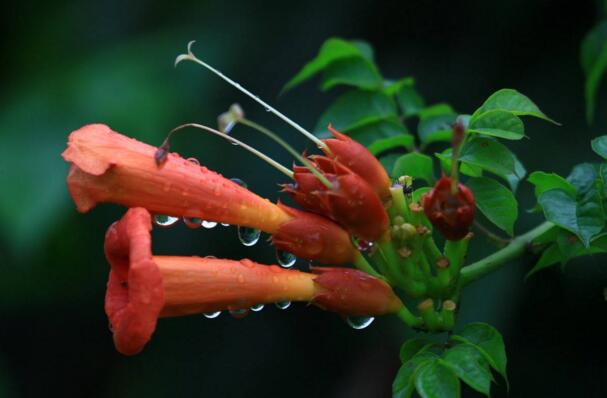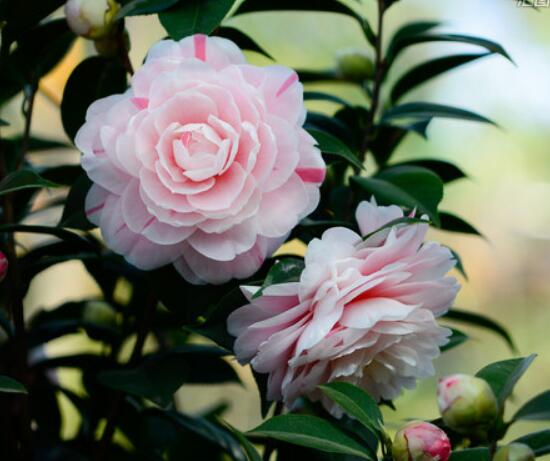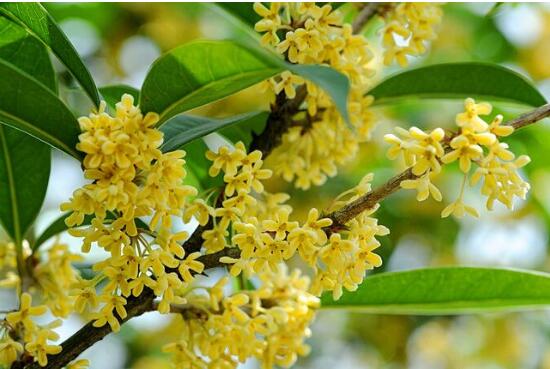What should I do if the flowers grow worms? pest control of Lingxiao flowers / spraying of diseased leaves
Lingxiao flowering period is long, raised at home can not only beautify the environment, but also purify the soul, is the favorite object of many flower friends. However, although Lingxiao flower is easy to raise, but for some reasons, it will also be found by bugs, that Lingxiao flower worms how to do? At this time, we should not be in a hurry, but should calmly find the cause, and then solve the problem. For this reason, the editor carefully arranged the pest control of Lingxiaohua. If you love flowers, you must have a look at them.
First, Lingxiao flower worm how to do, to find the cause

In the cultivation method of Lingxiao flower, we know that although Lingxiao flower is easy to raise, it also has requirements for the environment. Soil, light, water and so on should not be careless. Once operated improperly, worms or diseases will grow on the leaves. As for what to do with Lingxiao flower worms, take a look at the symptoms and solutions of the following pests, and you will know what to do.
(1) symptoms of Lingxiao flowers and insect pests and their solutions.
When it comes to the pest control of Lingxiao flower, the pest problem should be considered first. After all, once the plant grows insects, the consequences are very serious. It is understood that the main pests of Lingxiao flowers are whitefly, aphids and red spiders. Once found, flower friends should pay attention. The symptoms and solutions of Lingxiao flowers and insect pests are as follows:
1. Whitefly
This insect is one of the main pests of Lingxiao flower, it is a kind of white insect, it is difficult to distinguish with the naked eye. White whitefly larvae mainly adhere to the back of leaves and suck juice, causing leaves to curl and dry up; whitefly adults mainly harm tender leaves and absorb mesophyll juice.
Solution: when the above symptoms are found, flower friends will pay attention, look for bugs carefully, spray medicine in time after finding it, spray 40% omethoate, spray once every 7 days, and spray 3-4 times in a row. Note: both sides of the leaves should be sprayed, especially on the back, there will be a large number of insects.
2. Aphids
In the pest of Lingxiao flower, aphids can not be ignored, it is very small, about 1 mm, but a large number, it mainly attacks the leaves, stems and top buds. Because the terminal bud of Lingxiao flower is the most tender, aphids like to eat there most, and the tender terminal bud is not easy to deal with by hand, which is a headache and a very thorny thing.
Solution: it can be sprayed with 150 times omethoate solution and can be cured 1-2 times. When there are a large number of aphids, it is recommended to slowly irrigate the liquid once to put an end to the disease.
3. Red spider
This insect is difficult to distinguish with the naked eye at the initial stage of the disease. it will prick and suck leaves, buds and flower leaves, affecting normal growth and development, not only affecting beauty, but also leading to the death of the whole plant. So once you find a red spider, flower friends should pay attention!
Solution: when a small amount of red spider appears on the plant, it can be washed with clean water or scrubbed with soapy water; in severe cases, spray 1000 times dimethoate solution.
(2) the disease symptoms of Lingxiao flower and its solution.
Lingxiao flower bug how to do, read the above content we should know it! However, in addition to being attacked by insects, the disease is also harmful to Lingxiao flower all the time, and there are three main diseases: powdery mildew, gray mold and root rot. The specific symptoms and solutions are as follows:
1. Powdery mildew
This disease is one of the main diseases of Lingxiao flower, which mainly harms the stem, leaf and bud of Lingxiao flower. Symptoms: there will be a layer of white powder on the surface of the leaves, and in severe cases, the leaves will gradually wilt and bloom less, and the flowers will be small.
Liberating method: after discovering that the above symptoms are indeed powdery mildew, flower friends should immediately spray medicament, choose 2500 times liquid of strychnine or other suitable medicament, spray once every 10 days, spray 2-3 times continuously to cure the disease.
2. Grey mold
When it comes to the disease of Lingxiao, Botrytis cinerea has to say that it is easy to breed in a humid environment where the temperature is too low, which mainly harms the flowers of Lingxiao. Symptoms: waterlogged spots appear on the petals and sepals of Phalaenopsis, and then slowly form large brown round patches, and in severe cases, the whole flower will wither.
Solution: found that the above symptoms, has been difficult to solve, flower friends should be removed immediately, otherwise the disease will be contagious. However, the disease can be prevented by spraying a 65% concentration of Dyson zinc wettable powder 500-800 times, once every ten days, 2-3 times.
3. Root rot
It is easy to understand that the root is rotten, which can be said to be the most common disease of Lingxiao flower, which often occurs in the hot summer. The cause may be the root rot caused by too much watering.
Solution: after the disease is found, the root soil should be irrigated with 300 times Dysenamine solution in time, and timely ventilation, cooling and proper watering should be paid attention to to ensure that the basin soil is wet and not waterlogged.
As a good product of family farming, Lingxiao flower is easy to raise and has strong resistance to insects compared with other flowers. But no matter how to say, it is only a plant, sick worms are bound to exist, so in order for Lingxiao flower to grow healthily, we should master the above methods. With regard to the prevention and control of Lingxiao flower diseases and insect pests, the editor has introduced this, hoping to bring help to everyone.
What to do with the growth of worms? prevention and control of diseases and insect pests / 4 major diseases and 4 major pests
Goldfish grass, like its name, is shaped like a goldfish with bright colors, so it is a good product for indoor farming. In spite of this, the goldfish grass is still a plant, and it will inevitably be disturbed by insects, so what if the goldfish grass grows worms? In the process of cultivating goldfish grass, in addition to insect pests, disease is also one of the factors affecting the healthy growth of goldfish grass. As for the diseases and insect pests of goldfish grass, there are mainly 4 major diseases and 4 major insect pests. Let's go and have a look.
First, the goldfish grass worms how to do, looking for the cause
In the breeding methods of goldfish grass, we understand that goldfish grass has high requirements for the environment, not only soil and light, but also water and fertilization. Once there is negligence, insect pests and diseases will be found. As for the goldfish grass worms how to do, take a look at the following goldfish plant pest control, you will know.
(1) symptoms and solutions of insect pests in goldfish grass.
When it comes to the prevention and control of diseases and insect pests of goldfish grass, the first thing to consider is naturally pests. After all, if you raise plants, you will be affected by insects sooner or later. It is understood that there are four main pests of goldfish grass, thrips, whitefly, aphids and red spiders. Once found, flower friends should pay attention. The symptoms and solutions of insect pests in goldfish grass are as follows:
1. Thrips
This insect is not common, but it is one of the pests that harm the growth of goldfish grass. It is sent as adults or larvae on goldfish grass and feeds on young buds, tender leaves, flowers and young fruits. The symptoms of thrips are that the tender leaves curl after being eaten, and the shoots and flowers wither after being damaged.
Solution: when you find the above symptoms, flower friends should pay attention and look carefully. Once it is confirmed that it is this worm, you can immediately spray it with 25% ivy or 40% dimethoate 400 times.
2. Whitefly
White whitefly is a kind of white insect, which is difficult to distinguish with the naked eye. Larvae mainly adhere to the back of goldfish leaves and suck juice, causing leaves to curl and dry up, while adults harm tender leaves and absorb mesophyll juice.
Solution: when the above symptoms are found, flower friends can spray with 0.01% solution killed by the enemy, or spray 40% omethoate, once every 7 days, 3-4 times in a row.
3. Aphids
Aphids are one of the main pests that harm goldfish grass. They mainly damage the back of the leaves and suck the sap of young leaves and buds. The symptom of being attacked by this insect is that the leaves will wrinkle, turn yellow, and even fall off.
Solution: go to the market to buy an armyworm board and use it to catch and kill; in addition, flower friends can be sprayed with 150 times omethoate solution and can be cured 1-2 times. When there are a large number of aphids, it is recommended to slowly irrigate the liquid once to put an end to the disease.
4. Red spider
This insect is difficult to distinguish with the naked eye at the initial stage of the disease. it often hides on the back of branches and leaves or in dense places, sucking leaves, buds and flower and leaf fluid, affecting normal growth and development, not only affecting beauty, but also leading to the death of the whole plant.
Solution: when the worm is found, the net is hidden and it is easy to capture it manually. In addition, flower friends can use 20% trichloroacarol emulsion and add 8-1000 times water to make a solution spray, which has a good killing effect on adults, nymphs and eggs.
(2) the disease symptoms and solutions of goldfish grass.
Goldfish grass worms how to do, read the above content we should know it! However, in addition to being attacked by insects, the disease is also harmful to goldfish grass all the time, and there are mainly four kinds of diseases, namely, downy mildew, powdery mildew, gray mold and root rot. The specific symptoms and solutions are as follows:
1. Downy mildew
The disease is easy to occur in cold and humid environment, and it is one of the main diseases of goldfish grass. It mainly causes the growth of goldfish grass seedlings is blocked, yellowing and leaf curling downward. The symptom is that a layer of gray fluffy powder is produced on the back of goldfish grass leaves.
Solution: when the disease is mild, disinfect the soil, heat the greenhouse and improve the ventilation environment; when the situation is serious, basically finish, wait for the goldfish grass to die!
2. Powdery mildew
This disease is one of the main diseases of goldfish grass, which mainly harms the stems, leaves and buds of Artemisia przewalskii. Symptoms: there will be a layer of white powder on the surface of the leaves, and in severe cases, the leaves will gradually wilt and bloom less, and the flowers will be small.
Liberating method: if you find the above symptoms, flower friends should immediately spray the medicine, choose 2500 times liquid of strychnine or other appropriate agents, spray once every 10 days, spray 2-3 times continuously to cure the disease.
3. Root rot
The disease can be said to be the most common disease of goldfish grass, which often occurs in hot summer. The cause may be the root rot caused by too much watering. Mild infection may not destroy the whole plant, but weaken the growth, resulting in different branches, thin stems and short spikes.
Solution: after the disease is found, the root soil should be irrigated with 300 times Dysenamine solution in time, and timely ventilation, cooling and proper watering should be paid attention to to ensure that the basin soil is wet and not waterlogged.
4. Grey mold
The disease mainly affects the stems and flowers of Artemisia przewalskii. Symptoms: the yellowish-brown spot surrounds the entire stem, causing partial wilting of the upper plant, and in severe cases, flowers and infected parts show a large number of gray or light brown spores.
Solution: after the above symptoms are found, flower friends should remove them immediately, otherwise the disease will be contagious. In addition, 65% concentration of Dyson zinc wettable powder can be sprayed 500-800 times, once every ten days, 2-3 times.
- Prev

What about the growing insects of potted camellias? disease and pest control of camellias (spraying insecticides)
With the progress of pot technology, camellia has become a scenic spot in many people's homes. Insects can grow in any plant, and camellia is no exception. What about the camellia worms? The common pests of camellia are aphids, stem borer and red spider. For each kind of insect, its control methods are also different.
- Next

What about the growing insects of sweet-scented osmanthus in potted plants? control of diseases and insect pests of sweet-scented osmanthus (spraying for different diseases and insect pests)
Insects can grow in any plant, and sweet-scented osmanthus is no exception. With the progress of pot technology, sweet-scented osmanthus can also be raised at home. Sweet-scented osmanthus is one of the flower plants that can easily grow insects, so what about sweet-scented osmanthus worms? There are many kinds of insect pests in sweet-scented osmanthus, and each control method will be different.
Related
- Fuxing push coffee new agricultural production and marketing class: lack of small-scale processing plants
- Jujube rice field leisure farm deep ploughing Yilan for five years to create a space for organic food and play
- Nongyu Farm-A trial of organic papaya for brave women with advanced technology
- Four points for attention in the prevention and control of diseases and insect pests of edible fungi
- How to add nutrient solution to Edible Fungi
- Is there any good way to control edible fungus mites?
- Open Inoculation Technology of Edible Fungi
- Is there any clever way to use fertilizer for edible fungus in winter?
- What agents are used to kill the pathogens of edible fungi in the mushroom shed?
- Rapid drying of Edible Fungi

